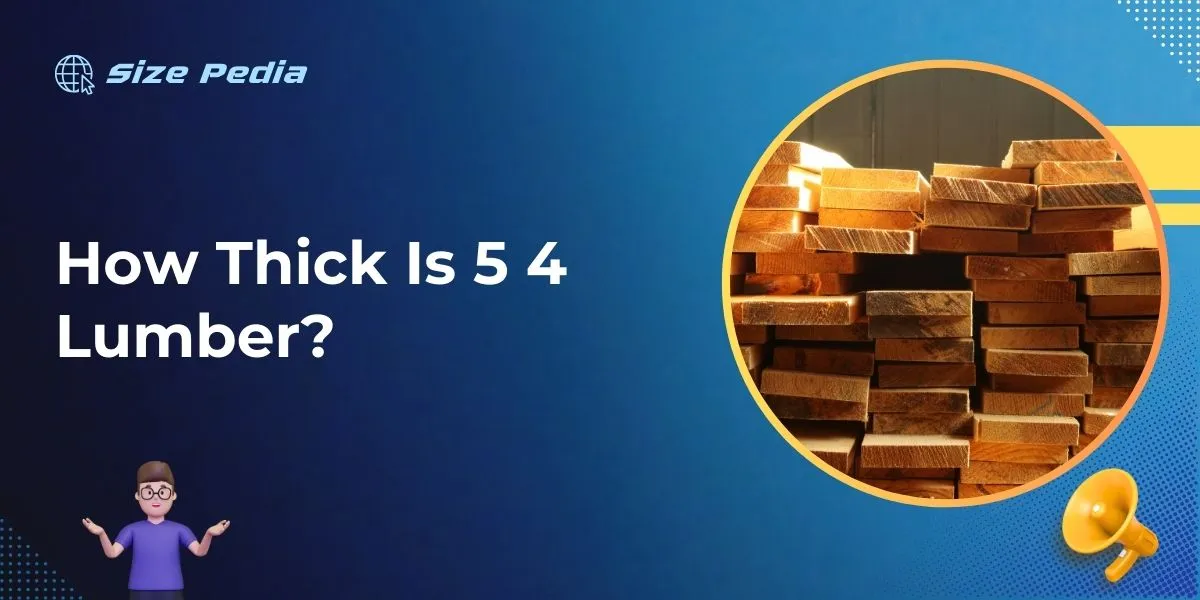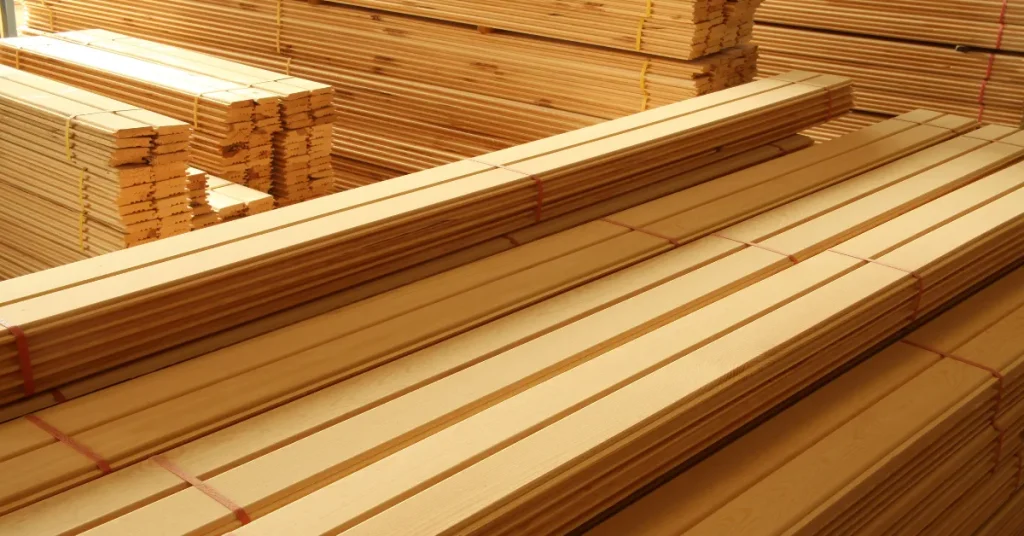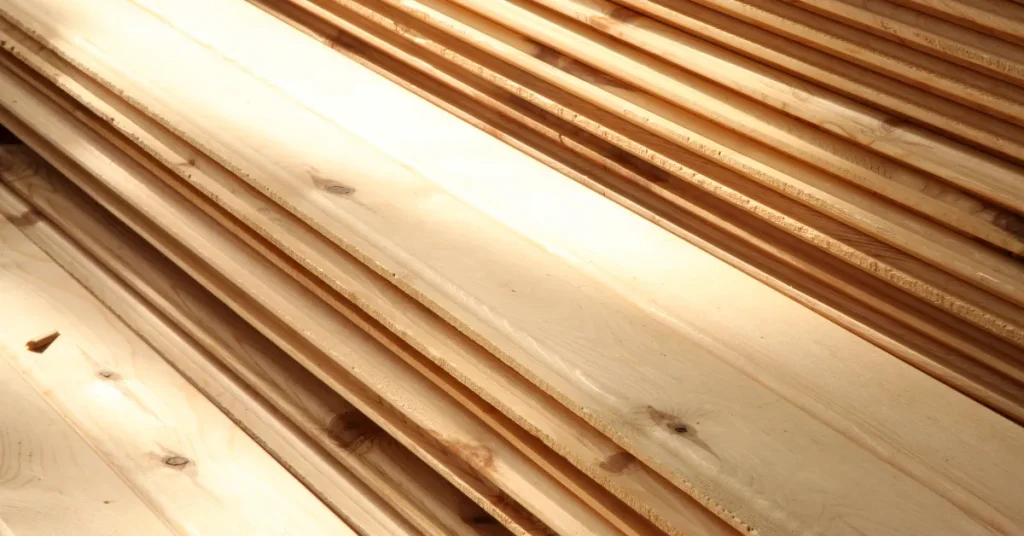5/4 lumber is actually 1 inch thick after being planed down from its rough-sawn thickness. It typically starts around 1 1/4 inches thick before finishing.
Understanding the actual thickness of lumber is essential for woodworking and construction projects. Dimensional lumber, like 5/4 deck boards, can be confusing since the “nominal” sizes do not match the “actual” sizes.
This discrepancy arises because lumber is often sold in its nominal dimensions, which refers to the size of the board before it undergoes drying and planing.
Contractors, DIY enthusiasts, and carpenters must recognize that the labeled thickness often represents a rough estimate rather than precise measurement.
Knowing that 5/4 lumber measures in at a true 1 inch thick after finishing can assist in accurate planning and budgeting for materials, ensuring that the end result of a project meets the desired specifications.

The Basics Of Lumber Thickness
Lumber thickness plays a vital role in a variety of construction and woodworking projects. Understanding how manufacturers label and measure wood is essential for buyers.
A common size many encounter is “5/4 lumber“. What does this mean in terms of actual thickness? Let’s delve into the details of lumber sizing and uncover the real measurements behind these nominal figures.
Nominal Vs. Actual Measurements
Nominal sizes are the simplified numbers used when referring to lumber thickness. They do not represent the real dimensions of the wood.
The term “5/4 lumber“, for instance, nominally suggests a thickness of 1 and 1/4 inches. In reality, the actual size is different because of something called “dressing.”
Dressing is the planing process lumber undergoes to make it smooth. This removes some of the wood’s thickness. So, in the case of 5/4 lumber, expect a smaller, actual size. This might be closer to 1 inch thick.
Understanding Lumber Sizes
Different lumber sizes have unique nominal and actual measurements. The industry standard dictates that 5/4 lumber typically gets planed down to 1-inch thickness. Yet, other sizes follow their own rules. Here’s a quick glance at other common lumber sizes:
| Nominal Size | Actual Thickness |
| 1x | 3/4″ (0.75 inches) |
| 2x | 1 1/2″ (1.5 inches) |
| 4x | 3 1/2″ (3.5 inches) |
| 6x | 5 1/2″ (5.5 inches) |
These general rules make understanding lumber sizes much simpler. Before purchasing wood, always confirm the actual measurements. Knowing the true thickness ensures a successful completion of any construction or woodworking project.
Decoding The Numbers
Decoding the Numbers behind lumber measurements can be quite the puzzle. When you encounter terms like 5/4 lumber, it’s essential to know exactly what you’re dealing with.
This number doesn’t just affect the thickness of the wood. It also has crucial implications for its suitability for various projects. Let’s break down these figures to make sure you nail your next woodworking endeavor!
What Does 5/4 Mean In Lumber?
Lumber sizes can be confusing. The term “5/4” represents a unique way of expressing the thickness of a board. Unlike what one might expect, this doesn’t translate to 1.25 inches of raw thickness.
Instead, it indicates that the lumber was once that thick, prior to being planed down. Standard practice in lumber milling involves reducing the size slightly to create a smooth, workable surface. Typically, a 5/4 board measures closer to 1 inch.
Reading Lumber Dimensions
Understanding lumber dimensions is key to buying the right wood for your project. Here’s a quick guide:
- The first number in a lumber dimension, like 5/4, refers to the board’s thickness before milling.
- After milling, the board’s actual size will be slightly less due to the surfacing process.
Manufacturers typically use nominal measurements when labeling and selling wood, so buyer awareness is crucial. Armed with this knowledge, you can ensure you’re getting the correct size for your project every time.
Here’s a simplified chart to help you visualize typical nominal lumber sizes and their actual dimensions:
| Nominal Size (inches) | Actual Size (inches) |
| 1 x 4 | 3/4″ x 3 1/2″ |
| 2 x 4 | 1 1/2″ x 3 1/2″ |
| 5/4 x 4 | 1″ x 3 1/2″ |
In summary, a 5/4 board typically measures 1 inch thick after milling. Remember to consider these measurements carefully when planning. It helps to avoid the inconvenience of ending up with a board that’s too thin for your project!
Standard Thickness For 5/4 Lumber

Understanding 5/4 lumber thickness is key for your woodworking projects. The term “5/4” refers to the thickness of the lumber when it is not yet planed or sanded. But what does this mean in actual measurements?
Typical Dimensions In The Industry
Lumber dimensions can be a bit confusing. The thickness for 5/4 lumber typically starts at 1 and 1/4 inches. That’s because lumber sizes are often named after their rough-sawn dimensions. Take note that the actual, final thickness might be less once the lumber is finished.
- Rough-sawn 5/4 lumber: usually about 1 and 1/4 inches thick.
- After planing and sanding: the thickness could reduce to about 1 inch.
Rough-sawn means the lumber has not been smoothed out yet. When finished, the wood will be smooth and might look thinner.
Variations In Thickness
Even with standards, thickness can vary depending on the mill and wood type. Different mills might cut slightly different thicknesses. The moisture in the wood can also affect its size. Drier wood might be a little thinner.
| Condition | Typical Thickness |
| Rough-sawn | 1 and 1/4 inches |
| Dried and planed | About 1 inch |
Different projects may need different thicknesses. Always measure twice and cut once. It ensures your project pieces fit perfectly.
Applications Of 5/4 Lumber
5/4 lumber packs the perfect balance of thickness for many projects. This type of lumber is not actually 1.25 inches thick. It’s usually 1 inch after drying and planing.
This size is versatile for multiple indoor and outdoor applications. Let’s explore how this lumber fits into various projects.
Common Uses For This Thickness
Outdoor decking and gardening structures often use 5/4 lumber. Its thickness ensures durability against the elements. Inside a home, it’s perfect for shelving and furniture.
- Decking boards
- Bench seats
- Raised garden beds
- Sturdy shelving
Choosing The Right Lumber For Your Project
Selecting 5/4 lumber means considering wood type and strength. For decks, choose treated lumber to resist rot. For indoor furniture, opt for fine hardwoods.
Here’s a quick guide:
| Project Type | Lumber Type |
| Outdoor Construction | Pressure-Treated, Cedar, Redwood |
| Indoor Furniture | Oak, Maple, Cherry |
Always check the lumber for straightness and defects. Use a moisture meter to ensure that the wood’s dryness is appropriate.
Measuring And Cutting 5/4 Lumber

Understanding the thickness of 5/4 lumber is key in woodworking projects. Measuring and cutting this specific type of lumber requires precision. Let’s dive into the tools and methods needed to handle 5/4 lumber accurately.
Tools For Accurate Measurements
To measure 5/4 lumber, select the right tools. Start with these essentials:
- Tape Measure: Ensure it’s long enough for your lumber piece.
- Carpenter’s Square: For right angles and straight edges.
- Marking Tools: Pencils or markers that are visible on wood.
- Calipers: For detailed thickness measurements.
Best Practices For Cutting To Size
Once measurements are taken, cutting with precision is the next step. Follow these best practices:
- Use sharp blades to ensure clean cuts.
- Support lumber properly to avoid splintering.
- Measure twice, cut once for accuracy.
- Keep hands clear of the cutting line.
- Wear safety gear such as goggles and gloves.
5/4 lumber thickness can often be confusing. It refers to lumber that’s 1.25 inches thick. This dimension can vary slightly after finishing. When buying, check if the lumber is surfaced or rough-sawn to estimate final thickness.
By employing the right tools and techniques, working with 5/4 lumber can create stunning projects with precise fit and finish.
Buying Tips For 5/4 Lumber
Starting a woodworking project brings excitement and a touch of anxiety. You face a big decision with 5/4 lumber. Knowing its actual thickness — typically 1-1/4 inches — is only half the battle.
You need to ensure the wood will last and won’t break the bank. Let’s dig into smart buying tips for 5/4 lumber, ensuring you pen down the best wood on a great deal.
Before you buy, assess the wood’s quality and durability. Keep these tips handy:
- Check for warps: Warped wood can ruin your project before it even begins.
- Look for knots: Small knots add character, but large ones can weaken the lumber.
- Examine grain patterns: Straight grains are better for structural strength.
- Consider the moisture content: Wood that’s too dry or too moist can cause problems later.
To find the best deals on 5/4 lumber, keep these strategies in mind:
- Compare suppliers: Prices can vary widely, so shop around.
- Look for discounts: Ask about bulk discounts or special promotions.
- Purchase off-grade: Consider if lower grades could work for non-structural elements.
- Buy in the off-season: Prices may drop during slower months.
FAQs About How Thick Is 5/4 Lumber
What Is The Actual Size Of 5 4 Trim?
The actual size of a 5/4 trim, often referred to in lumber terms, typically measures 1 inch thick by 3. 5 inches wide.
How Thick Is A Quarter Lumber?
Quarter lumber typically measures 3/4 inch (19mm) in thickness. This size is standard for many woodworking projects.
What Lumber Is 1 Inch Thick?
Lumber that is 1 inch thick is commonly known as “4/4” in the lumber industry, indicating it is one quarter inch.
What Is Lumber Sizing 6 4?
Lumber sizing “6/4” refers to wood that is 1. 5 inches thick. This notation indicates the board’s rough-cut thickness before planing or finishing.
Conclusion
Understanding the dimensions of 5/4 lumber is crucial for your woodworking projects. Remember, this stock is typically 1 inch thick, not 1. 25 inches. It’s essential for precision in construction and crafting.
Always double-check with your supplier to ensure the exact measurements you require for a successful build.
Keep building smart!
Resources:
1. https://www.fpl.fs.usda.gov/documnts/fplgtr/fplgtr190/chapter_07.pdf
